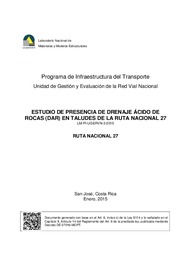| dc.contributor.author | Naranjo Ureña, Ronald | |
| dc.contributor.author | Valverde Cordero, Christian | |
| dc.contributor.author | Garro Mora, José Francisco | |
| dc.contributor.author | Ruiz Cubillo, Paulo | |
| dc.contributor.author | Barrantes Jiménez, Roy | |
| dc.contributor.author | Loría Salazar, Luis Guillermo | |
| dc.date.accessioned | 2017-03-01T16:06:01Z | |
| dc.date.available | 2017-03-01T16:06:01Z | |
| dc.date.issued | 2015-01 | |
| dc.identifier.uri | https://www.lanamme.ucr.ac.cr/repositorio/handle/50625112500/39 | |
| dc.description.abstract | El presente trabajo se enfoca en determinar mediante análisis de laboratorio de pH en paste y geoquímica de aguas, la existencia de drenaje acido de roca (DAR) en los taludes de la Ruta Nacional No.27.
Los análisis de pH en paste se realizaron a rocas y suelos alterados de dos taludes ubicados en los estacionamientos 45+600 y 48+000 respectivamente. Mientras que los análisis de geoquímica de aguas se realizaron a muestras de agua estancada y de drenajes a lo largo de varios puntos de la ruta. Los resultados de laboratorio, así como las evidencias físicas observadas en el campo, muestran que hay sitios a lo largo de la Ruta Nacional No.27 donde efectivamente se está dando DAR. Se observó como el DAR está afectando directamente las propiedades químicas y físicas del concreto lanzado que se colocó sobre los taludes, el acero electrosoldado y las cunetas construidas para el manejos de aguas superficiales, ocasionando su colapso y generando un peligro para los usuarios. El sitio de estudio ubicado en el estacionamiento 45+600 presentaba indicios de DAR, pero los análisis realizados en el laboratorio mostraron que en este lugar no se está dando este proceso. Se recomienda estudiar la zona más hacia el norte donde posible si se está dando proceso y podría llegar a afectar la línea del ferrocarril. Se confirmo la afectación por DAR en el estacionamiento 48+000, donde se midieron muestras de pH tan bajo como 1.5 (similar a la concentración de una celda de batería de plomo). Es muy importante realizar análisis de pH en pasta en todos los sitios donde se tenga sospechas de que está ocurriendo DAR, para confirmar o descartar su presencia. La importancia de identificar este proceso químico y físico que está alterando las roas y los suelos de los taludes en los cortes de la carretera, es fundamental para plantear las medidas correctivas adecuadas y resolver el problema o al menos minimizar los efectos negativos y su influencia en la inestabilidad de taludes de la ruta. | es |
| dc.description.abstract | This report focuses on determining by the laboratory analysis of pH paste and geochemistry of water, the existence of acid rock drainage (ARD) on the slopes of the National Route No.27.
The analysis of pH paste were made in altered rocks and soils from two slopes, located in stations 45+600 and 48+000. Geochemical analysis of water were made to stagnant water and water from drainage in several points along the route. Laboratory results, as well as the physical evidence observed in field, show that there are sites along the National Route No.27 which indeed ARD is occurring. It was observed as the ARD is directly affecting the chemical and physical properties of shotcrete that was placed on the slopes, also the welded steel and the ditch built for the managing of surface water, causing it to collapse and creating a hazard for the users. The site in study located in the station 45+600 showed signs of ARD, but the analysis in the laboratory showed that in this place is not occurring this process. It is recommended to study the northern area where is possible that this process is occurring and could affect the railway line. It was confirmed that ARD is affecting the station 48+000 , where the pH of the samples measured were as low as 1,5 (similar to the concentration of the cells of a lead battery). It is very important to perform the pH paste analysis at all sites where is suspected ARD is occurring, to confirm or exclude its presence. The importance of identifying the chemical and physical process that is altering the rocks and soils of the road cuts, it is essential to set the appropriate corrective measures and resolve the problem or at least minimize the negative effects and their influence on slope instability of the route. | es |
| dc.language.iso | es | es |
| dc.publisher | Laboratorio Nacional de Materiales y Modelos Estructurales (LanammeUCR) | es |
| dc.relation.ispartofseries | LM-PI-UGERVN-03-2015 | |
| dc.subject | PITRA | es |
| dc.subject | Drenaje ácido | es |
| dc.subject | alteración hidrotermal | es |
| dc.subject | ruta 27 | es |
| dc.subject | Caldera | es |
| dc.subject | Acid drainage | es |
| dc.subject | hydrothermal alteration | es |
| dc.subject | Route 27 | es |
| dc.title | Estudio de presencia de drenaje ácido de rocas (DAR) en taludes de la ruta nacional 27 | es |
| dc.type | informe técnico | es |
| dc.description.procedence | UCR::Vicerrectoría de Investigación::Unidades de Investigación::Ingeniería::LanammeUCR | es |

